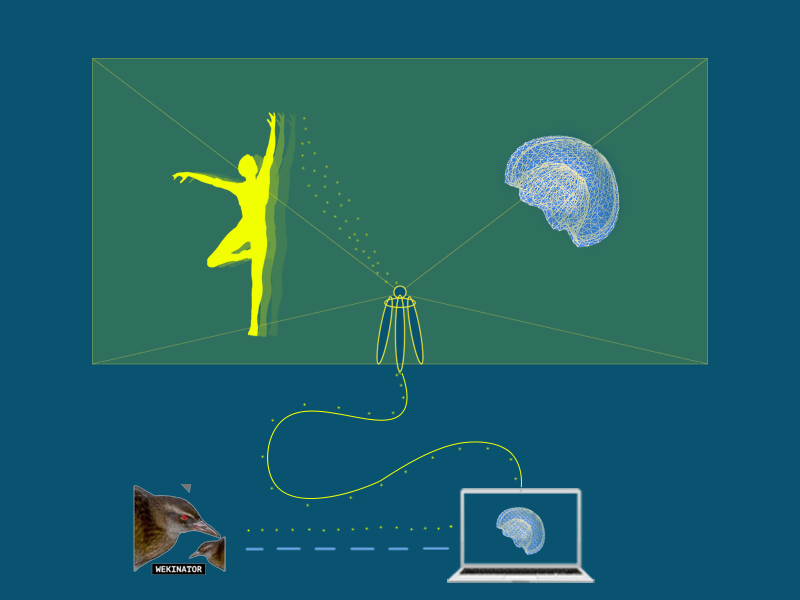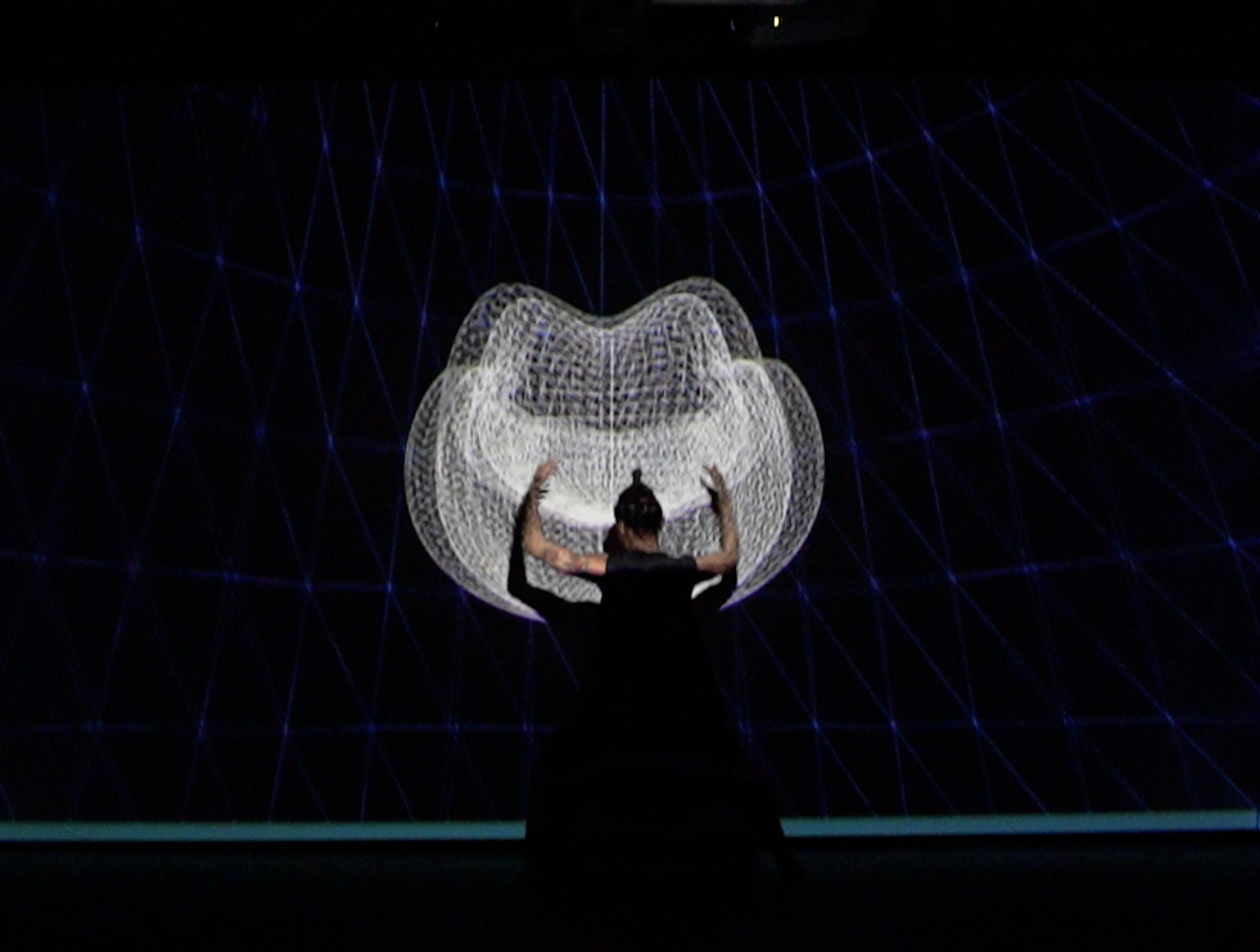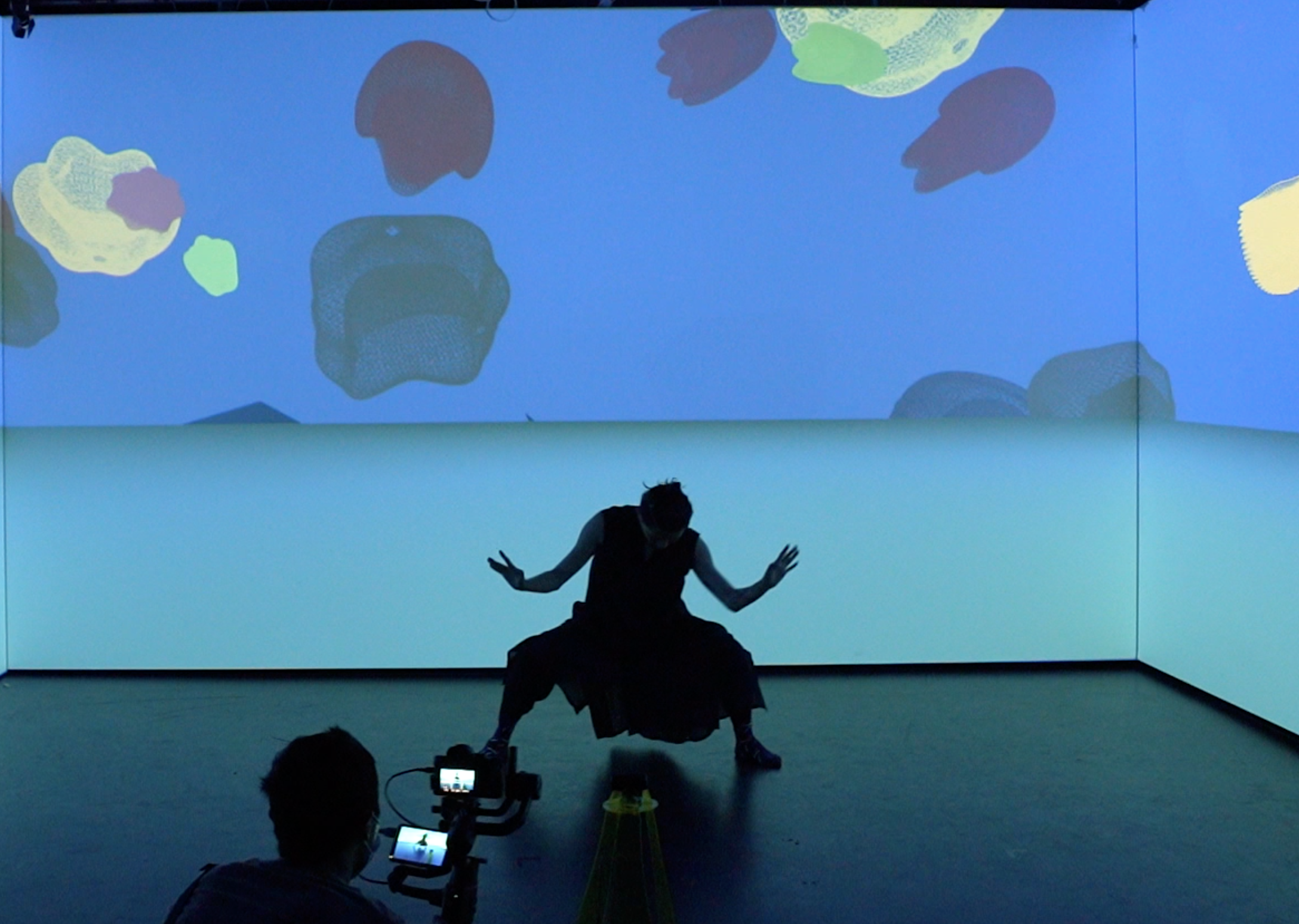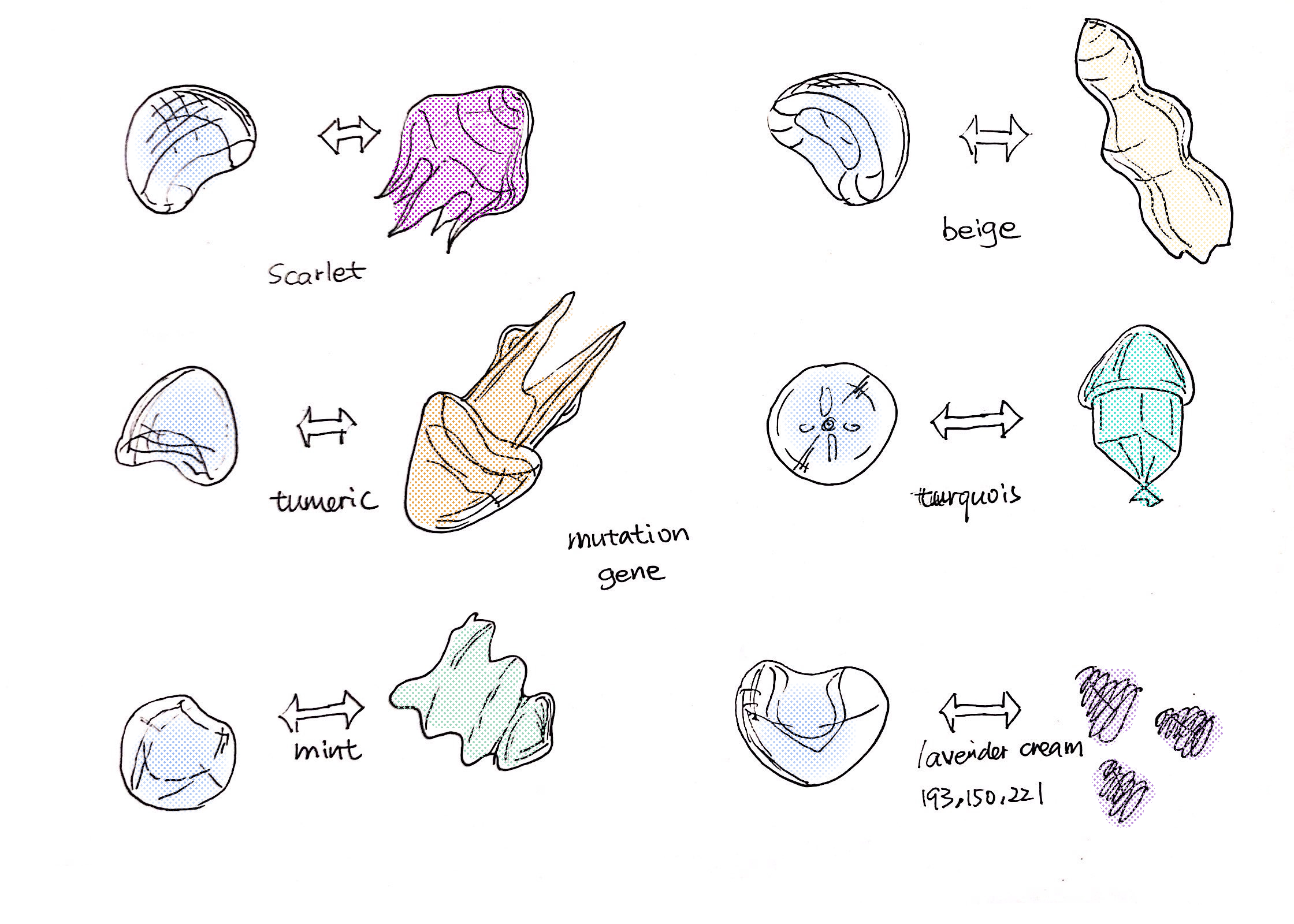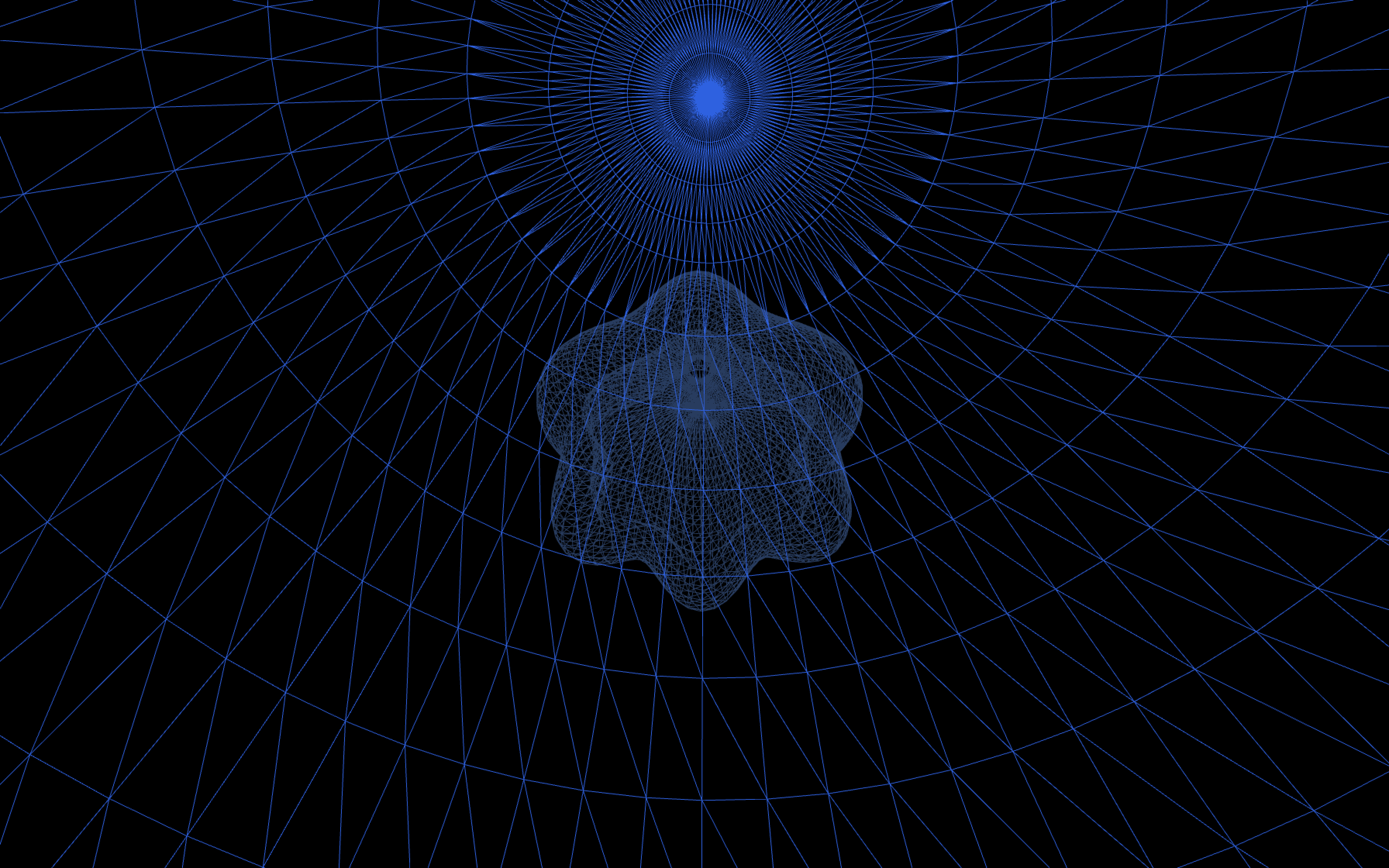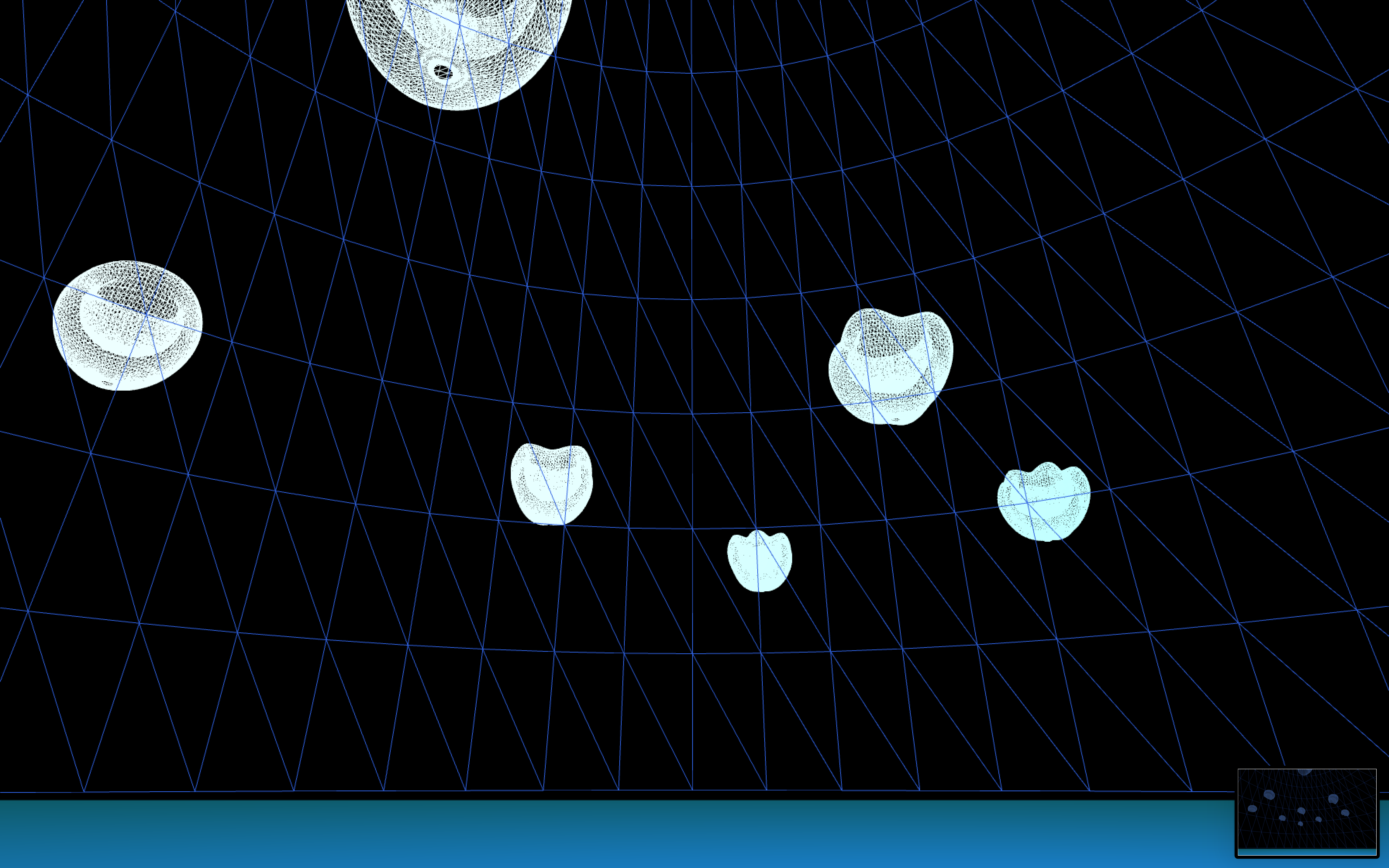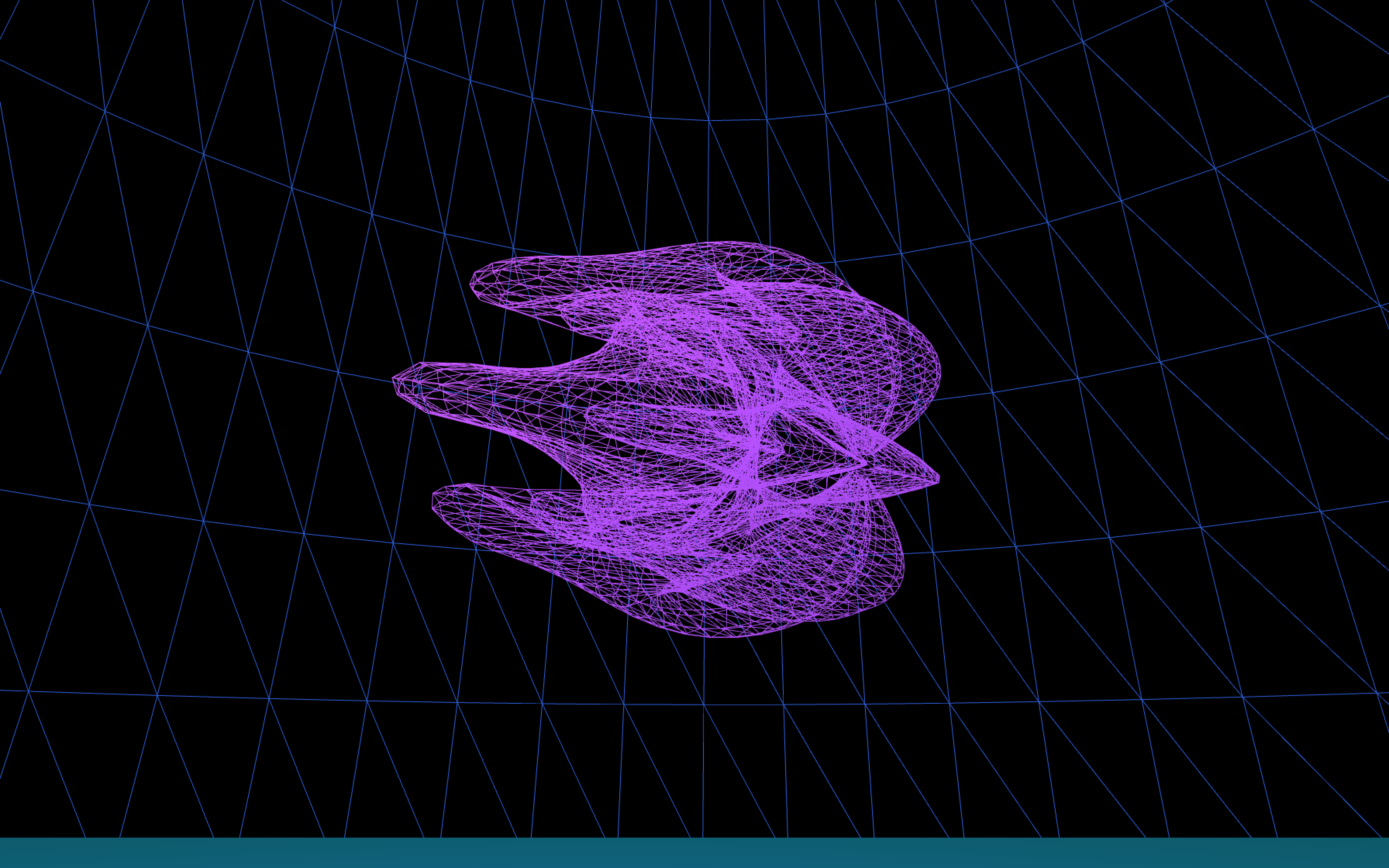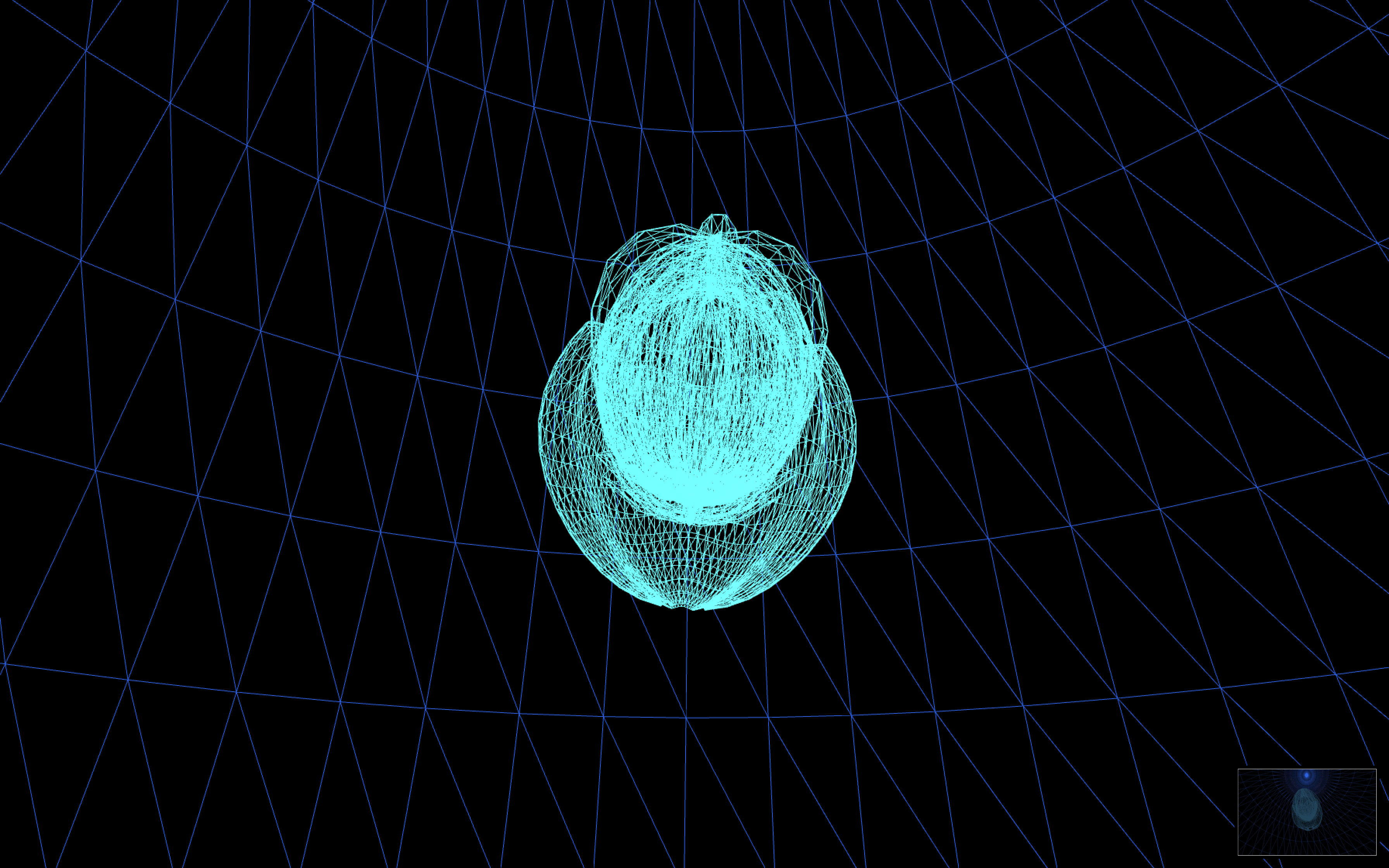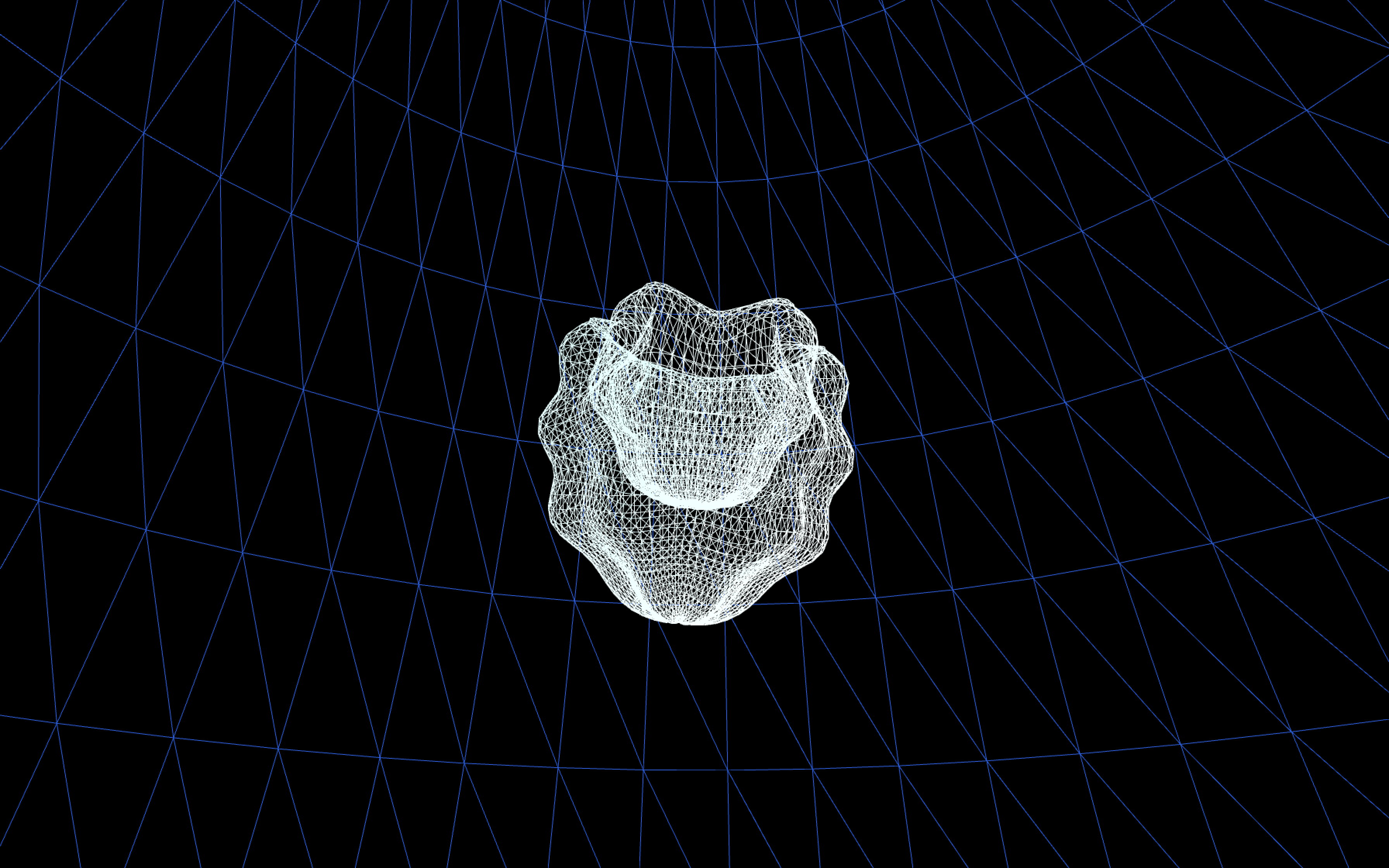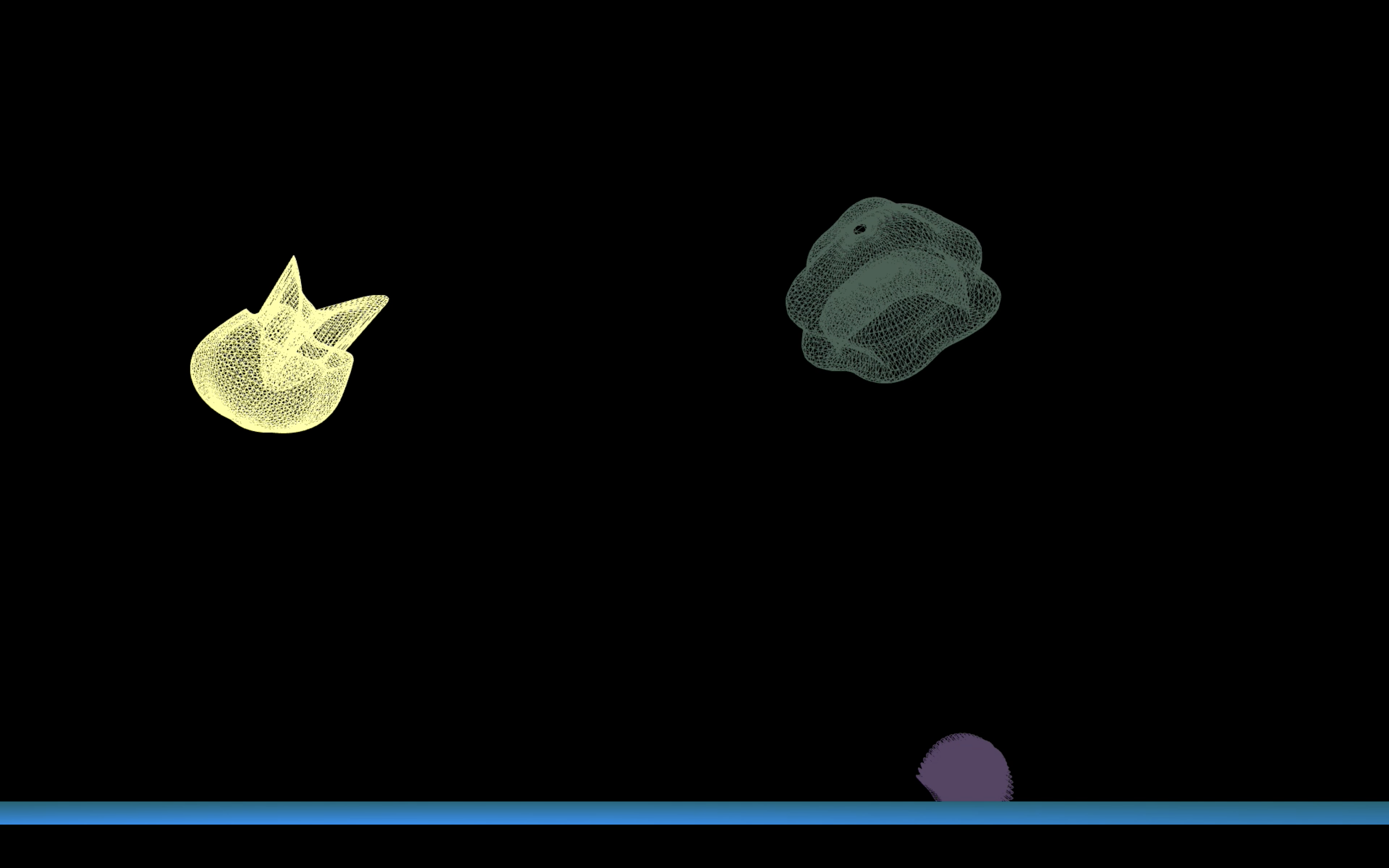All is a transient dream: a journey exploring Jellyfish’s shared consciousness through intra-active audio-visual performance
In Daniel Quinn’s novel ‘Ishmael’[1], an interspecific dialogue unfolds between a jellyfish and a gorilla. The conversation is about the evolution of different species. As a result, the jellyfish reluctantly took the honour of being a pinnacle of the evolutionary process because they proceed strictly on the basis of ‘observation, logic and the scientific method’[2]. These 96 percent water entities mock the omnipresent aggrandisement of human beings as the essence of all creatures. Jellyfish are bio-machines, emotional AI and a multi-layered interconnected conscious web.
With the help of computation, ‘All is a transient dream’ simulates this temporal-spatial dialogue between ‘gorilla’ and ‘jellyfish’, physical and virtual, organisms and machines. Hence in this project, performers and an interactive system that materialises itself through the imitation of jellyfish as well as the dancing motion of the performer. This interactive performance intends to illustrate a dynamic relationship between organisms and machines through a series of visual effects, free-flowing choreography and special commissioned soundtrack.
created by: Zhang,Yishuai
All IS A TRANSIENT DREAM
WORLD PREMIER 2020
Chimera Garden
Machines: simulating computational intra-action
‘All is a transient dream’ is an interactive system written in c++ coding language. During the live performance, machines (camera, laptop) can directly use unprocessed data that are generated from the detection of pixel differencing among large amount of captured frames. Nevertheless, machines can also take the same data and process it using machine learning algorithms: the decision tree classification method, outputting highly customised outcomes. These two different approaches of data processing will be visually demonstrated through the transmutative forms and the altering roaming trajectories of digital jellyfish, respectively. By analysing and interacting with the visualised system that produces sensory differences, a new idea emerges based on the theory of ‘Intra-action’[3] evoked by Karen Barad.
The notion of intra-action queers the general idea of ‘causality’, questions the default linear casual relations between various cultural and social phenomena as well as the existing social dominance fostered by severe ethico-onto-epistemological[4] dichotomies. Distinct from interaction, the on-going reiterative intra-actions do not deflect responsibility, but rather facilitate the materialisation of the notion of individuality in the making of spacetimemattering[5]. To respond to the characteristic of intra-action, a transmutative jellyfish form is designed to be able to visually synchronise with the motions of performer by transforming its shape, which is depending on which segment of the algorithmic ‘genes’ is activated. The visual transformation of jellyfish is fluid and dissonant, generating diversity as well as the tendency to trace back to its origin. As Barad stated in an interview[6]:
“We should make inquiries into how differences are made and remade, stabilised and destabilised, as well as their materialising effects and constitutive exclusions”
The fluid yet dissonant process of visual transmutation of jellyfish materialises itself through the temporal-spatial transformation induced by the performing body, which includes the ultimate uncertainty — an improvising performing body into the system. Therefore the relationship between organisms and machines could be described as a dynamic state of being that switches its state between dissonance, resonance, and some in-between states. The immanent trait of intra-action ultimately fuses the livings and inanimate into one giant mongrel of beings, doings and a congealing of both intentionally and promiscuously distributed agencies.
The intention to simulate intra-action explores the innovative possibilities of creating agencies that are not intentionally assigned to ‘optimal’ routes or functions that root for anthropocentrism. The non-linear characteristic of causality is manifested by change of perspectives. The entangled ethico-onto-epistmology can only reach its fluid equilibrium with the collective making of spacetimemattering reflected from multiple perspectives. Jellyfish, with a speculative collective consciousness, have already quietly permeated our mind through the dazzling appearance and unsettling enigma.
Organisms: collective intra-action as shared consciousness
The mystery and breath-taking beauty of jellyfish have aroused great interest from human beings for centuries. In fact, we have no idea how long these aqueous species have existed on earth or if they are rather extraterrestrial invaders from ancient times. Although the oldest known fossils of jellyfish have been found in rocks in Utah that are more than 500 million years old[7], scientists still can not corroboratively agree on their origin. Turritopsis dohrnii, a biologically immortal kind[8], prolong their life by reverting completely to a state sexually immaturity[9]. The marvellous transmutative immanent quality of T.dohrnii and other species of genus Aurelia[10] fulfils the dreams of being immortal, which many powerful human beings were dying for. Another immortal polyp, Hydra[11]regenerates merely by reproducing a limb. Its enigmatic nature makes it uncertain whether it should be classified as an animal or a plant. In addition to scientific studies, this magical critter is also adored by fascinated artists who explore the various innovative aspects of jellyfish.
In the theory of the artwork ‘win > < win’ by Haug/Kaegi/Wetzel, jellyfish are flourishing because of three reasons. Firstly, abandoned plastics in the ocean kill their predators; secondly, they prefer warmer water caused by climate change; thirdly they thrive in the increased acidity caused by rising oceanic CO2 levels. Their varied attitudes towards human activities, ranging from resilience and indifference to preference, arouse various non-anthropocentric fantasies that frequently emerge in science and art related subjects. However, for divers, they are hardly amicable creatures. In an article ‘Jellyfish do more with less than almost anything’ written by Jack and Anne Rudloe, the part-time aggressive water creatures suddenly became the protectors of the shrimps, defending them from potential threats. Additionally, they have also been observed supporting their primary predator - sea turtle’s baby. They become the defender of the mother nature, elegantly invigilating the grand oceanic world.
Frequently, the role of jellyfish in the ecosystem has been neglected as aesthetic attachments overlap and conflict with concerns for ecosystem balance and biodiversity. However, in 2009, a research paper[12] proved jellyfish’s significance in ecosystem with the notion of Keystoneness[13]. The ‘Keystoneness’ of a species in its ecosystem is computed from the ratio of the sum of its direct and indirect impacts on all other groups in the system over its biomass. As a high-impact predator with a relatively low biomass, ‘thanks’ to global warming, the booming of jellyfish finally caught more attention from related industries such as marine science institutions and fisheries[14]. Now their beings and doings are starting to have an unprecedented influence on many aspects of human reality.
Recently, a growing body of research[15] suggests that the cognitive gap between human and other animals is much narrower than what was formerly supposed.The notion of different kind of species is now more likely to be seen as a consistent spectrum than discretely separated individuals. However, individuality materialises itself through different noumenal reality[16],forged by a spectrum of various lateral metamorphosis in space and time. Jellyfish’s intra-actions are throughout their collective activities within the ecosystem as well as their mysterious biological variations.
In my piece ‘All is a transient dream’, the original jellyfish is embedded with 7 different genetic sections that can tranform its body into various shapes if and when activated. Those computational genes, which are named after colours, can react to the environmental signals that materialise through the motion data inputs. Artistically, jellyfish’s body is constructed by a series of closed curves, pulsing with the flow of water. Their collective consciousness or recognition is metaphorically designed as a huge circular dome with the same texture — curves. The uniform aesthetic style allows the animated transformation to be visually cohesive and coherent. This especially speaks to the metamorphic nature of jellyfish, everlastingly rejuvenating, sharing and being the pelagic mysterious consciousness, gracefully shimmering in the darkness.
Computational and Organismic Entanglement through audiovisual choreography
The explorative journey of jellyfish’s shared and connected consciousness reveals itself through the emergent behaviours of both performers and computational systems. There are seven choreographic visual tableaus displayed during the performance. Each represents a simulated evolving process of jellyfish.
Beginning with the first tableau ‘Ocean Sunrise’, jellyfish landed on earth, spawned in the ocean and slowly spread their traces and consciousness around the living environment. Then, in ‘Pseudo-freedom’, jellyfish began to roam in the space, while exploring its physical reality, embracing their given freedom by nature. In ‘Golden age’, jellyfish thrives with the ‘assistance’ of human activities, deliberately expanding their collective consciousness throughout the ecosystem. In the next scenario ‘cybernetic contingency’, Jellyfish begins its transmutative journey, wandering between their shared consciousness(the big circular sculpture) and sea level(earth). They proceed on the basis of their collective consciousness while being pulled by the earthly empowerment including human activities (performer motion). Following with the next tableau ‘Calibrated Freedom’, jellyfish exist between this reality and their metaphysical reality, endlessly celebrating their evolutionary diversity. In ‘Quantum Leap’, jellyfish would conquer the ocean, bringing another prosperous era to the oceanic realm, reviving the liveness of marine creatures. Last, in the final tableau ‘shared consciousness’, jellyfish break through the limitation of species, finally becoming a dragon, a ghost , an alien.
The choreography is co-created by Yishuai and Michael Scerbo who performs in ‘All is a transient dream’. It unfolds through the exploration and navigation of a spectrum of resonance between the jellyfish tableaus, performer and the music. The so-called free-flowing choreography is compiled to resonate and dissonate with jellyfish, illustrating with infinite colour palettes to compose audience experience.
‘All is a transient dream’ is a temporal-spatial dialogue viewed from multiple perspectives. From machines, it is a mathematical ritual to break those normalised rules, embracing dissonance and resonance both as the materialisation process within its immanent ‘intra-action’. From the perspective of jellyfish as a species, it is most likely to be a romanticised farce that desperately seeks for attention from the jellyfish spirit. Yet the artistic speculation still remains its enigma as French philosopher Merleau-Ponty[17] wrote beautifully and meticulously:
‘What makes the weight, the thickness, the flesh of each colour, of each sound, of each tactile texture, of the present, and of the world, is the fact that he/she/they who grasps them feels himself/herself/themselves emerge from them by a sort of coiling up or redoubling, fundamentally homogenous with them; he/she/they feels that he/she/they is the sensible itself coming to itself.’
This process of sensory manifestation combines both performer and audience’s perspectives, transforming into an immersive experience for all involved. The intra-action of organisms envelopes the intra-action of machines as space and time are warped by the multiple-perspectives, the energy field generated by orgasms and the frequencies carrying sound and mechanical vibrations. ‘All is a transient dream’ illustrates a temporal-spatial existence that flows through the resonant and dissonant warping of space and time:
‘I am not a gorilla’
‘I am a jellyfish’
Further Development
The art practices and researches of Zhang Yishuai always tends to merge different fields into emerging artistic phenomena, demonstrated through visual and auditory outputs that are influenced by our reality. In order to build a more holistic computational interactive system which also includes interactive sound, some new technical skills such as sonification method, frequency analysis and MaxMSP should be acquired. In his future interactive audio-visual projects, Yishuai would audaciously look beyond the theatrical elements of performance, instead, delve into the realms of web-based interactive performance as well as the application of VR environment.
Self-evaluation
All in all, I think I have reached my own expectation for this project. The 4-month long process of making this project has tremendously benefited me in various aspects. For instance, I become more skilful at time and project management. Since this project involves many different types of work such as coding, design, music production and choreography, I was pushed to come up with a strategy as well as many backup plans. This whole planning and obeying procedures make me realise that how significant persistence should be valued. However, there was a period when I started to commit more time in interactive sound-related study. A hunch came to me after couples of day's studying, it told me that I should spend more time in visual interactivity instead of commencing a new study task. I changed my plan accordingly and finally 'saved' my project.
We need one sort of uncertainty in our daily artistic practices, which opens more space for the infinite possibilities. We need to obey and disobey, the action speaks eloquently only when viewed from different perspectives and taken with patience and endeavour. Let persistence become the big pillar of our dreamed existence.
Special Thanks to:
Performer: Michael Scerbo
Music Producer: SHISHI (https://soundcloud.com/shishi428)
My friend Duncan Paterson for proofreading this article.
Code Reference
1.Christopher Baker. ofxPS3EyeGrabber. Copyright (c) 2014 Christopher Baker
2.Theo Papatheodorou. Optical flow controller. ‘Creative Coding Workshop 2'.https://learn.gold.ac.uk/mod/page/view.php?id=720872
3.Marcin Ignac. Cindermedusae. http://marcinignac.com/projects/cindermedusae/
4.Daniel Shiffman. NOC_2_6_attraction. The Nature of Code. http://natureofcode.com
5.James George. Model Distort Example. Openframeworks workshop at Eaves Festival Vienna. 2012
6.Rebecca Fiebrink. Wekinator2. Kadenze Machine Leraning for artist and musician. 2017
References
[1] Daniel Quinn, ‘Ishmael’, Bantam Books, 2017.
[2] Ted Toadvine, ‘How Not be a Jellyfish : Human Exceptionalism and the Ontology of Reflection’. C. Painter and C. Lotz (eds.), Phenomenology and the Non-Human Animal, 39–55. © 2007 Springer.
[3] Karen Barad, “Quantum entanglements and Hauntological Relations of Inheritance: Dis/continuities, spacetime enfoldings, and Justice-to-Come,” Derrida Today vol. 3, no. 2 (Nov. 2010): 240–68.
[4] Evelien Geerts, Delphi Carstens, ‘Ethico-onto-epistemology’. Philosophy Today. DOI: 10.5840/philtoday202019301
[5] Scantlebury, Kathryn & Danielsson, Anna & Hussenius, Anita & Gullberg, Annica & Andersson, Kristina. Using Spacetimemattering to Engage Science Education with Matter and Material Feminism. 10.1007/978-3-030-01974-7_4. 2019.
[6] Adam Kleinman. ‘Intra-actions’. Mousse 34 ~ Karen Barad.
[7] Susan Halgedahl, Richard Jarrard, Antonio Marques, Allen Collins.‘Fossil Record Reveals Jellyfish More than 500 Million Years Old’. News Release 07-159. National Science Foundation. https://www.nsf.gov/news/news_summ.jsp?cntn_id=110511.2007
[8] Schuchert P, ed. (2012). "Turritopsis dorhnii (Weissmann, 1883)". World Hydrozoa database. World Register of Marine Species. Retrieved November 29, 2012.
[9] Bavestrello, Giorgio; Christian Sommer; Michele Sarà (1992). "Bi-directional conversion in Turritopsis nutricula (Hydrozoa)". Scientia Marina. 56 (2–3): 137–140. 1992.
[10] He; et al. (2015-12-21). "Life Cycle Reversal in Aurelia sp.1 (Cnidaria, Scyphozoa)". PLOS ONE. 10 (12): e0145314. Bibcode:2015PLoSO..1045314H. doi:10.1371/journal.pone.0145314. PMC 4687044. PMID 26690755. 2015.
[11] Maija Tammi, Ville Tietavainen. ‘Immortal: Lost Memoirs of Cornelia Dulac Concerning the Freshwater Polyp Hydra’.Aalto University.2020.
[12] Daniel Pauly, William Graham, Simone Libralato, Lyne Morissette, M.L. Deng Palomares. ‘Jellyfish in ecosystems, online databases, and ecosystem models’. Hydrobiologia 616(1): 67-85. 2009.
[13]Huang Jianhui, Han Xingguo. ‘Keystone species: what is keystoneness?’ Acta Phytoecological Sinica. 25(4):505-509. 2001.
[14]Ruckelshaus, M., T. Klinger, N. Knowlton & D. R. Demaster. Marine ecosystem-based management in practice: scientific, and governance challenges. Bioscience 58: 53–63. 2008.
[15]See, for instance, Donald Griffin. Animal Minds: Beyond Cognition to Consciousness, rev. ed. (Chicago: University of Chicago Press, 2001);Marc Beckoff, Colin Allen, and Gordon Burghardt, eds. Cognitive Animal: Empirical and Theoretical Perspectives on Animal Cognition (Cambridge, Mass: MIT Press, 2002);Haraway, Donna Jeanne. The Companion Species Manifesto : Dogs, People, and Significant Otherness. Chicago, Ill. : Bristol :Prickly Paradigm ; University Presses Marketing, 2003;Benson, Etienne. JAC, vol. 30, no. 3/4, 2010, pp. 825–834. JSTOR, www.jstor.org/stable/20866975. Accessed 10 Sept. 2020.
[16] Stanford Encyclopedia of Philosophy, ‘Kant’s Transcendental Idealism’, chapter 6.1, https://plato.stanford.edu/entries/kant-transcendental-idealism/#ThinThemNoumTranObje.2016
[17] Merleau-Ponty, Le Visible et l’invisible (Paris: Gallimard, 1964), 153; The Visible and the Invisible, trans. by Alphonso Lingis. (Evanston: Northwestern University Press, 1968), p. 114. Hereafter, this text will be cited as VI, with French preceding English pagination.































































